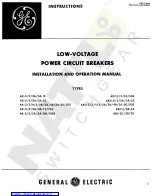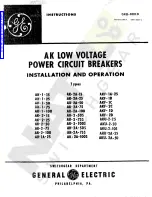
KRB-5404
79
6. MAINTENANCE, INSPECTION AND PARTS REPLACEMENT
This chapter describes the maintenance and inspection procedure for the AR series ACBs.
The service life of the ACB depends on the working and environmental conditions. The ACB is exposed to mechanical and
electrical stresses and thus suffers gradual degradation during use, which will increase the possibility of malfunctions. Preventive
maintenance and periodical inspection are very important to avoid any functional degradation, prevent malfunctions, extend the
service life, and ensure safe operation.
The appropriate frequency of maintenance and inspection of the ACB varies depending on the installation conditions, the number of
tripping operations, the magnitude of breaking current, and other factors that are to be considered empirically. As a guideline, Table
40 shows the recommended inspection frequency. See section 6-1 for detailed maintenance and inspection procedures.
Table 40 Frequency of maintenance and inspection
Category
Working and environmental
conditions
Inspection
level
Frequency in interval or number of open/close cycles
Interval
Number of open/close cycles
Normal
•
Not so dusty,
•
Not so much corrosive gases,
•
Ambient temperature: 35
C
or lower
•
Not so humid,
•
Number of open/close cycles
per day: 2 or less
Ex. Switchboards in electric
installation rooms,
Control rooms,
Building installation
Normal/
Detailed
•
Every year or 2 years
•
Every year after 3 years
since installation
•
Every half year after 6
years since installation
Open/close
condition
800AF or less
1000AF -
2500AF
3200AF or
more
Nearly no current
level
Every 1000 cycles
Rated current
level
Every 1000
cycles
Every 500
cycles
Every 100
cycles
Thorough
•
Every 5 or 6 years
•
Every 4 years after 6 years
since installation
•
Every year or 2 years after
10 years since installation
Every 4000 cycles
Overhaul
When abnormality is found during normal or through inspection
Harsh
•
Highly dusty,
•
Much corrosive gases,
•
Ambient temperature: 45
C
or higher,
•
Highly humid,
•
Number of open/close cycles
per day: 4 or more,
•
Always exposed to vibrations
Ex. Iron or chemical plants
Engine rooms (without
ventilation),
Cogeneration installation,
Ferryboats
Normal/
Detailed
•
Every year
•
Every half year after 2
years since installation
Open/close
condition
800AF or less
1000AF -
2500AF
3200AF or
more
Nearly no current
level
•
Every 1000 cycles
•
Every 500 cycles after 1000 cycles
Rated current
level
•
Every 1000
cycles
•
Every 500
cycles after
1000 cycles
•
Every 500
cycles
•
Every 250
cycles after
500 cycles
•
Every 100
cycles
•
Every 50
cycles after
100 cycles
Thorough
•
Every 2 or 3 years
•
Every 2 years after 6 years
since installation
•
Every year after 10 years
since installation
•
Every 2500 - 3000 cycles
•
Every 2000 cycles after 3000 cycles
Overhaul
When abnormality is found during normal or through inspection
Abnormal
•
Open/close operation due to
overload,
•
Tripping due to shortcircuit,
•
Accidentally submerged
Thorough When abnormality occurs
Open/close
condition
800AF or less
1000AF -
2500AF
3200AF or
more
Overcurrent level
(approx. 6 times
the rated current)
Every 25
cycles
Every 25
cycles
Every 25
cycles
Level exceeding
overcurrent level
Every time
Every time
Every time
Overhaul
When ACB is deemed to be repairable at through inspection
Normal inspection includes inspection and actions that can be done only with removing the arc chamber, contacts, front cover and
the like. Normal inspection can be performed by the user. Terasaki also provides normal inspection service.
Detailed inspection includes inspection, actions, and parts replacement that will be done to prevent functional degradation caused by
aging or the like when abnormality is found during normal inspection.
You are recommended to use Terasaki’s detailed inspection service.
Thorough inspection must be left to Terasaki. Overhaul will be do
ne in a Terasaki’s factory.
About the service life
The expected service life of AR series ACBs is shown in the "Endurance in number of ON-OFF cycles" rows in Tables 3 and 4.
"With maintenance" in the tables means that appropriate inspection, maintenance, repair, and parts replacement are performed
according to the instructions in this chapter. But, when an ACB performs three times of tripping operation nearly at the rated
breaking current (three standard operating duty cycles), it is at the end of its safe service life even if thorough inspection is done
every time it trips open. Such an ACB will be apt to suffer malfunctions and should be replaced without delay to avoid frequent
inspection and parts replacement. See section 6-2 for detailed parts replacement procedures.













































